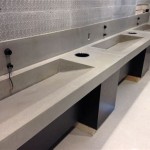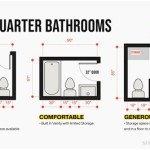How Much Does It Cost to Install a New Bathroom Mirror?
Installing a new bathroom mirror can significantly enhance the aesthetic appeal and functionality of the space. The cost associated with this home improvement project can vary considerably, influenced by factors such as the size and type of mirror, the complexity of the installation, and the geographic location. Understanding these variables is crucial for budgeting accurately and making informed decisions.
This article provides a comprehensive overview of the cost factors involved in bathroom mirror installation, offering insights into the range of expenses that homeowners can expect. It delves into the different types of mirrors available, the labor costs associated with professional installation, and potential additional expenses that may arise during the process.
Factors Influencing the Cost of a Bathroom Mirror
The primary determinant of the installation cost is the mirror itself. Mirrors come in a wide array of sizes, shapes, and styles, and their price points reflect this diversity. Basic rectangular or oval mirrors are typically the most affordable, while more elaborate designs, such as those with integrated lighting, defogging features, or custom frames, command higher prices.
The size of the mirror directly correlates with its price. Larger mirrors require more glass and resources to manufacture, thus increasing their cost. Consider the dimensions of the available wall space and the desired visual impact when selecting a mirror size. A larger mirror can create the illusion of a more spacious bathroom, but it will also contribute to a higher overall installation cost.
Frameless mirrors, offering a minimalist and modern aesthetic, often cost less than framed mirrors. Framed mirrors, however, provide an opportunity to coordinate with the bathroom's existing décor and can add a touch of elegance or personality. The cost of a framed mirror depends on the material used for the frame, with options ranging from basic wood or metal to more luxurious materials like handcrafted ceramics or ornate carvings. Opting for a custom frame can further increase the cost.
Specialized mirrors, such as those with integrated LED lighting or anti-fog technology, are premium options that enhance functionality and convenience. LED mirrors provide consistent and even illumination for grooming tasks, while anti-fog mirrors eliminate the need for manual wiping after a shower. These features add to the upfront cost of the mirror but can be worthwhile investments for homeowners seeking enhanced convenience and aesthetics.
Consider the complexity of the mirror's design and installation requirements. A simple mirror that can be easily mounted on the wall will generally have lower installation costs compared to a more intricate design that requires precise measurements or specialized mounting hardware. Mirrors that integrate with existing electrical systems for lighting or defogging features necessitate the expertise of a qualified electrician, further contributing to the overall cost.
Labor Costs for Bathroom Mirror Installation
The second significant component of the installation cost is labor. While some homeowners may choose to install a mirror themselves, professional installation is often recommended, particularly for larger or more complex mirrors. Professional installers possess the necessary skills, tools, and experience to ensure a secure and aesthetically pleasing installation.
Labor costs can vary depending on the installer's hourly rate, the complexity of the installation, and the geographic location. Plumbers, handymen, and general contractors are all qualified to install bathroom mirrors. It is advisable to obtain quotes from multiple professionals to compare pricing and ensure competitive rates.
Hourly rates for plumbers or handymen can range from $50 to $150 or more, depending on their experience and the local market. The total labor cost will depend on the estimated time required for the installation. A simple mirror installation may take an hour or two, while more complex installations, such as recessed mirrors or those requiring electrical work, can take several hours or even a full day.
The complexity of the installation significantly influences labor costs. If the existing wall requires modifications, such as patching holes or reinforcing the structure to support a heavy mirror, this will add to the labor time and expense. Similarly, if the installation involves running electrical wiring for integrated lighting or defogging features, the cost will increase due to the need for a licensed electrician.
Geographic location plays a role in labor costs. Areas with a higher cost of living typically have higher labor rates. Metropolitan areas generally have more competitive rates compared to rural locations, where the availability of qualified installers may be limited. Obtaining multiple quotes from local professionals is essential to ensure a fair and competitive price.
Before hiring an installer, it is crucial to verify their credentials and ensure they are licensed and insured. This protects the homeowner from liability in case of accidents or damage during the installation process. Checking online reviews and asking for references from previous clients can provide valuable insights into the installer's reputation and quality of work.
Additional Costs Associated with Bathroom Mirror Installation
In addition to the cost of the mirror and labor, several other potential expenses may arise during the installation process. These additional costs should be factored into the overall budget to avoid unexpected financial burdens.
One potential cost is the removal and disposal of the old mirror. If the existing bathroom mirror needs to be removed before the new one can be installed, the installer may charge an additional fee for this service. The complexity of the removal process depends on the size and type of the old mirror, as well as how it is attached to the wall. Proper disposal of the old mirror is essential to prevent injury from broken glass.
Wall repairs may be necessary if the existing wall is damaged or requires modifications to accommodate the new mirror. Patching holes, repairing drywall, or reinforcing the wall structure can add to the overall cost. It is advisable to inspect the wall carefully before starting the installation process and address any necessary repairs beforehand.
Electrical work is a common additional cost, particularly if the new mirror has integrated lighting or defogging features. Running new electrical wiring, installing outlets, or connecting the mirror to the existing electrical system requires the expertise of a licensed electrician. Electrical work can be a significant expense, so it is important to obtain a detailed quote from a qualified electrician before proceeding.
Hardware and supplies are typically included in the installer's estimate, but it is essential to confirm this. The installer may need to purchase specialized mounting hardware, adhesives, or sealants to ensure a secure and watertight installation. These materials can add to the overall cost, especially if the mirror is heavy or requires specific mounting techniques.
Permits may be required for certain types of bathroom renovations, particularly those involving electrical or plumbing work. Check with the local building department to determine if permits are necessary for the mirror installation. Obtaining the necessary permits ensures that the work complies with local building codes and regulations.
Contingency funds are always recommended for any home improvement project. Unexpected issues can arise during the installation process, such as hidden plumbing or electrical wiring, which may require additional work and expense. Setting aside a contingency fund of 10-15% of the total project cost can provide a buffer to cover unforeseen expenses.
The price of the mirror and the cost of labor is also impacted by the type of mirror purchased and installed. Below is a breakdown of the types of mirrors available and how they impact cost.
Types of Bathroom Mirrors and Their Associated Costs
The type of bathroom mirror selected has a significant impact on the overall installation cost. Different mirror styles offer varying levels of functionality, aesthetics, and complexity, influencing both the material cost and the labor required for installation.
Standard flat mirrors are the most common and affordable option. These mirrors are typically rectangular or oval and can be frameless or framed. The cost of a standard flat mirror depends on its size and the material used for the frame, if any. Installation is usually straightforward, involving mounting the mirror directly to the wall with screws or adhesive.
Beveled mirrors have edges that are cut at an angle to create a decorative effect. The beveled edge adds a touch of elegance and sophistication to the mirror. Beveled mirrors can be more expensive than standard flat mirrors, as the beveling process requires additional manufacturing steps. Installation is similar to standard flat mirrors, but extra care may be needed to ensure proper alignment.
Vanity mirrors with built-in lighting provide enhanced illumination for grooming tasks. These mirrors typically feature LED lights that surround the perimeter of the mirror, providing consistent and even lighting. Vanity mirrors with lighting can be significantly more expensive than standard mirrors, as they require electrical wiring and specialized components. Installation requires the expertise of a licensed electrician to connect the mirror to the electrical system.
Medicine cabinet mirrors combine the functionality of a mirror with the storage space of a medicine cabinet. These mirrors are typically recessed into the wall and feature shelves for storing toiletries and medications. Medicine cabinet mirrors can be more complex to install than standard mirrors, as they require cutting an opening in the wall and ensuring proper alignment and support. The cost of a medicine cabinet mirror depends on its size, features, and the complexity of the installation.
Pivot mirrors allow the user to adjust the angle of the mirror for optimal viewing. These mirrors are typically mounted on a pivoting mechanism that allows them to be tilted up or down. Pivot mirrors can be more expensive than standard mirrors, as they require specialized mounting hardware. Installation involves attaching the pivoting mechanism to the wall and ensuring it is properly aligned and secured.
Magnifying mirrors provide a magnified view for detailed grooming tasks, such as applying makeup or shaving. These mirrors typically feature a small magnifying lens that is attached to the main mirror. Magnifying mirrors can be handheld, wall-mounted, or tabletop. The cost of a magnifying mirror depends on its size, magnification power, and mounting style. Installation is usually straightforward, involving attaching the mirror to the wall or placing it on a tabletop.
Smart mirrors are a newer technology that integrates a mirror with a digital display. These mirrors can display information such as the time, weather, news, and social media updates. Smart mirrors can be significantly more expensive than standard mirrors, as they require complex electronic components and software. Installation requires the expertise of a qualified technician to connect the mirror to the internet and configure its settings.
Antique mirrors, distinguished by their aged or distressed appearance, contribute character and vintage charm to bathrooms. This aesthetic is achieved via chemical treatments or special finishing processes. Antique mirrors generally carry a higher price tag than standard mirrors, reflecting the sophisticated techniques employed in their creation. Installation, while similar to standard mirrors, necessitates extra care to preserve the mirror's delicate finish and prevent damage during the mounting process.
Understanding the different types of bathroom mirrors and their associated costs is essential for making an informed decision. Consider your budget, aesthetic preferences, and functional needs when selecting a mirror for your bathroom. Obtaining quotes from multiple installers and suppliers can help you find the best value for your money.

Install A Recessed Vanity Mirror

Bathroom Mirror Frames 2 Easy To Install Sources A Diy Tutorial Retro Renovation

Bathroom Renovation Diy Mirror Makeover My Happy Simple Living

How To Install A Mirrorchic Bathroom Mirror Frame Momhomeguide Com

Install A Recessed Vanity Mirror

Home Living 24 In W X 36 H Rectangular Frameless Led Wall Bathroom Vanity Mirror Glossy White Color Changing Bm64872led The Depot

Bathroom Makeover On A Budget How To Frame Mirror Simply2moms

Modern Abacus Frameless Led Illuminated Silver Bathroom Mirror With Anti Fog Royal Bathrooms

John Lewis Halo Colour Changing Illuminated Bathroom Mirror

How To Install A Bathroom Mirror The Home Depot







